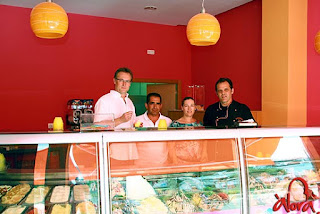Man not in Alora for a bit.
All this stuff
A carpet, two suitcases, two folding bikes, a soft bag, a sack of lemons, 37 bottles of wine, a cool box full of mostly pork products, a laptop, a dog in a cage, his food and water, a rucksack, a big bag of shoes, a box full of something, another box of ? clothes, a camera tripod, a big kitbag full of clothes, cheese, a picnic rucksack and 55 litres of extra virgin olive oil and Mrs.Sanchez (standing).
fitted into this
plus driver
Back in Brum.
The Málaga area really does have a different climate from the rest of Spain. It shares its weather with northern Africa. We've had hot and sunny weather for weeks now. There is always an interim period where we change from opening the windows to let in the warm air to warm the house, to shutting the windows and shutters to keep the warm air out. Anyway, we set off in shorts and T shirts etc., drove for 6 hours towards Madrid and then we noticed it had gone cold. Then the driving rain started.A couple of hours later the receptionist at the Hotel Palacio Valderabanas in Ávila clocked our tropical garb and gave us a knowing look.
(Ávila is the highest provincial capital in Spain (1132 metres/3714 ft. above sea level/very high up.). Buxton, the highest market town in England is a mere 1000ft. above sea level.)
Ávila.
'We've come from Málaga.' says I. 'Why?' says the chap behind the desk.
Luckily the heating was on in our room and 'Las Cancelas' round the corner had Crujiente de morcilla con compote de manzana (black pudding with pine nuts in batter with apple sauce) and Judías del Barco de Ávila con chorizo y oreja (dirty big beans in a stew with chorizo and pig's ear). Just the ticket on a cold wet night in June.
I forget what Mrs. Sánchez had.
Judías del Barco de Ávila con chorizo y oreja (Mmmm.)
Ávila was an arabic town from 714AD. until it was almost totally destroyed in the battles of the Christian reconquest. In about 1100 it was rebuilt and repopulated by anyone Alfonso V1 could persuade to live up there. The magnificent walls were probably built in about 1200 but no-one can remember exactly when. In 1367 it was attacked by some English footy fans on their way to a Champions League game in Madrid. They burnt a few houses but couldn't penetrate the 1000 mighty walls (mil muros) which some say is how the team got its name.
Ávila went downhill after that despite it being the home of St. Teresa of Ávila (1515-1582) who was a mystic and founded the 'Barefoot Carmelites'. In 1620 she nearly became the Patron Saint of Spain, but Santiago Matamoros (St. James the Moor slayer) was felt to reflect the national zeitgeist and was chosen instead. She has remained very popular, though, and the town is visited by thousands of her fans and the shops do a roaring trade in little statues and medallions. Here is one of her famous sayings:
"I know by frequent experience that there is nothing which puts the devils to flight like holy water".
Saint Teresa of Ávila
We bought some black pudding with pine nuts here.
Isabella, Queen of Castille died here before being taken 350 miles to Granada to be interred with her husband Ferdinand who was already dead. The 'Treaty of Medina del Campo' was signed here in 1489 between England and Spain . Both countries agreed to dislike France and Catherine of Aragon was told by her mum, Queen Isabella that she had to marry Prince Arthur, Henry VII's son and then his brother Henry VIII. She was one of the wives that died with her head intact. That's a bit of history for you.
Medina del Campo was famous for its fairs for over 100 years but went downhill in the 18th. century only to become popular again when the railway arrived and they started opening the shops on Sundays which is unusual for Spain.
Just time for a stop at Rueda to buy some Yllera wine and then off to Santander and the good ship Pont Aven.
June 23rd. 2013




















